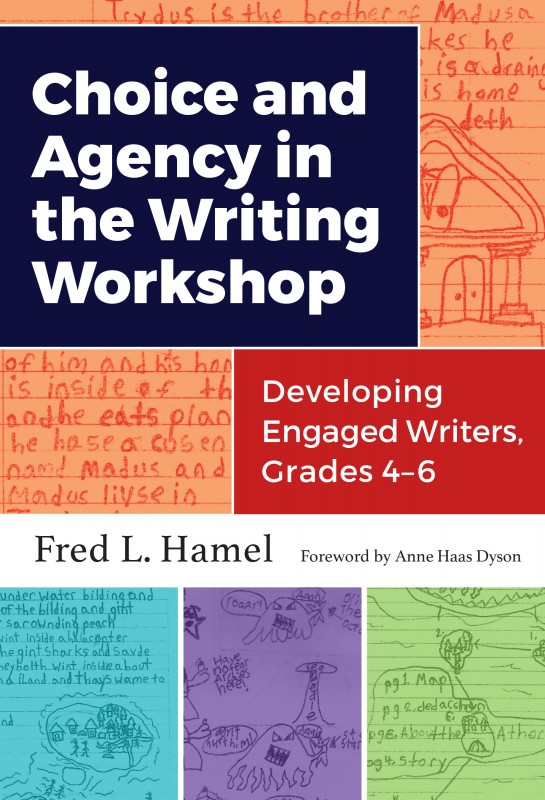How giving schoolchildren more freedom in their writing helped them learn and enjoy the written word
TACOMA, Wash. – What happens when 9-year-old kids in a classroom are encouraged to treat writing as “play and exploration,” rather than as “work”?
Does learning fall by the wayside? Do the students fail to take their work seriously? And do they gain or lose confidence in their abilities?
In his new book, Choice and Agency in the Writing Workshop: Developing Engaged Writers, Grades 4–6, Fred L. Hamel, professor in the School of Education at University of Puget Sound, reveals what happened when he and a fourth-grade teacher decided to create a weekly writing workshop that allowed students greater autonomy than is typical in school
“Our work was experimental; we were curious how kids would respond given fewer prescriptions and more trust as writers,” Hamel says. “Students, it turns out, responded well.”
Many kids experienced what Hamel calls “relief” from a tightly paced curriculum. They exhibited increased motivation, and parents were often thankful to have children experience literacy more on their own terms. Hamel calls the book “an observational, reflective study about paying attention to the range of things kids do to make acts of writing accessible and meaningful.”
Over five years, working in an urban, middle-class elementary school, Hamel observed, analyzed, and recorded the student reactions he found in the writing workshop, and the challenges and rewards the two educators encountered.
The result: Students came to write about what interested them; they imitated a range of genres; and they drew upon diverse resources—including drawing, video games, dramatizing, and classroom relationships.
“Students used writing,” Hamel says, “to build friendship connections and to navigate social tensions.” Overall, the educators found widespread engagement—as well as surprises.
“The students engaged with popular media more than we anticipated,” Hamel explains. “They wrote about TV characters, such as SpongeBob SquarePants, and depicted video-game sequences from Super Mario. It was not uncommon for students to ask to stay in during recess to write, as they became caught up in their work.”
In addition, students who struggled with traditional or “prescribed” writing practices made strides they otherwise might not have made.
Martin, a fourth grader, became absorbed in drawing detailed images of castles and monsters from video games. Hamel and his colleague realized that, rather than being a distraction, Martin’s drawings were a pathway into his writing development. The teachers invited Martin to talk about his drawings; they wrote down what he said and read it back to him. Martin began to experience his own writing voice and to “hear” his expertise. He gradually began to include labels and dialogue in his pictures. Still an emerging writer by the end of the year, Martin had a collection of stories, and both Martin and his teachers saw his writing as successful and powerful.
Shepherded by careful listening and teacher support, students began to view themselves as writers, and they met a range of learning goals, though not necessarily in linear, lockstep fashion. They found ways to share writing actively and to communicate with real audiences in mind.
“The extended time I spent with these writers helped me to get beyond the surface to see the richness and interwoven complexity of their writing and to get closer to their starting points—to how they might learn,” Hamel says.
Choice and Agency in the Writing Workshop is a book for teachers, university-based teacher educators, and parents. Rich with classroom narratives, the book covers themes such as:
· the intersection of writing, drawing, and thinking
· conceptualizing writing as play and exploration
· the importance of a listening stance in writing conferences
· tensions in providing choice and agency in an era of accountability
· shaping community membership in writing classrooms
“I hope to help educators and adults take another look at literacy development,” Hamel offers, “one predicated on the possibilities that emerge when we stay in the moment with kids as they develop as writers, when we take time to listen, and when we build upon what they bring to their acts of writing.”
“Fred Hamel not only offers us readers insight into the text-mediated dramas of children’s lives, he allows us into the sort of pedagogical reflections that keep us all in the flow of becoming,” wrote Anne Haas Dyson, professor, College of Education, University of Illinois.
“Through classroom examples, Hamel helps us to see the complex and entangled identities of teachers and students,” Candace R. Kuby, associate professor, College of Education, University of Missouri, wrote. “This book asks us all to consider putting less emphasis on expected writing endpoints and think more about the social processes and relationships of literacies coming to be.”
For more information on the book visit: tcpress.com/choice-and-agency-in-the-writing-workshop-9780807758557
Press photos of Fred Hamel and the book cover can be downloaded from pugetsound.edu/pressphotos
Photos on page: From top right: The book cover; Fred Hamel, by Ross Mulhausen, University of Puget Sound
Tweet this: How kids learn to write: Book by Fred Hamel @univpugetsound ‘Choice and Agency’ #writing #education #teachereducation http://bit.ly/2oGi9Xo
Follow us on Twitter! twitter.com/univpugetsound

